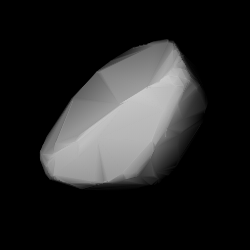 Descamisada modeled from its lightcurve | |
| Discovery [1] | |
|---|---|
| Discovered by | M. Itzigsohn |
| Discovery site | La Plata Obs. |
| Discovery date | 27 June 1951 |
| Designations | |
| (1588) Descamisada | |
Named after | Eva Perón (Argentine idol) [2] |
| 1951 MH | |
| main-belt ·(outer) Eos [3] | |
| Orbital characteristics [1] | |
| Epoch 4 September 2017 (JD 2458000.5) | |
| Uncertainty parameter 0 | |
| Observation arc | 65.75 yr (24,017 days) |
| Aphelion | 3.2477 AU |
| Perihelion | 2.8073 AU |
| 3.0275 AU | |
| Eccentricity | 0.0727 |
| 5.27 yr (1,924 days) | |
| 141.67° | |
| 0° 11m 13.56s / day | |
| Inclination | 11.268° |
| 98.591° | |
| 224.93° | |
| Physical characteristics | |
| Dimensions | 17.541±0.174 [4] 25±11 km (generic) [5] |
| 0.141±0.014 [4] | |
| 11.3 [1] | |
1588 Descamisada, provisional designation 1951 MH, is an Eos asteroid from the outer region of the asteroid belt, approximately 18 kilometers in diameter. It was discovered on 27 June 1951, by astronomer Miguel Itzigsohn at the La Plata Astronomical Observatory in La Plata, Argentina, and named in honor of Eva Perón. [2] [6]